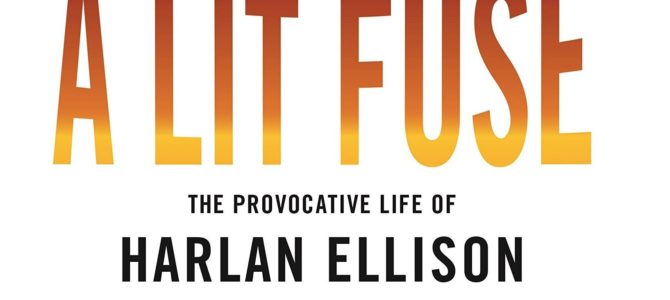
One of the pitfalls for a biographer is to fall in love with his subject, and thus produce an unbalanced work that leaves out the warts. An additional danger is the fear factor when a biographer’s subject has a sledgehammer wit, an inflated ego brooking no disagreement, a refusal to let even the mildest of criticisms go by, and penchant for lawsuits (that is one of the chief reasons that biographers of Gore Vidal only wrote a warts-and-all treatment after Vidal was safely dead).
So it is that Nat Segaloff has undertaken the very tricky task of writing A Lit Fuse: The Provocative Life of Harlan Ellison. Segaloff has been friends with his subject, the still-living and thus verbally, sometimes physically, and notoriously litigious Harlan Ellison, for 20 years, first coming to him as a fan-boy.
Like many others, Segaloff is understandably awed by Ellison who has written skillfully in many genres—television scripts, mysteries, horror, op-ed columns, book and film reviewing. He is unique in being a science fiction writer (he angrily demands his field be called “speculative fiction”) who has won, along with eight Hugos (for science—oops—speculative fiction), several Bram Stoker Awards (for horror), and Edgars (for mystery), as well as the Pen Award for Journalism.
In person as well as in print, Ellison is a larger-than-life figure who is a spell-binding talker with a compelling background. As a teenager he rode the rails with hobos; joined Martin Luther King Jr. in the Selma March; had his live saved by Steve McQueen; and took martial arts lessons from Bruce Lee. Ellison’s personal magnatism comes across in this biography because Segaloff often gives the floor to the writer.
That said, the portrait of Ellison that emerges is less what you would expect of a biography and more what would emerge from a collection of unedited interviews, not only with Ellison, but also his friends and detractors (and sometimes those familiar with Ellison embody both). Ultimately, Ellison is an unappealing figure: egotistical to the point of having delusions of Godhood, intolerant, and hateful.
His loudly proclaimed progressive politics rival those of his friend, the “Blame America First” Communist sympathizer Ed Asner. (In a dead giveaway of his own politics, Segaloff dedicates the biography to Asner.) Making matters worse, Ellison is often hypocritical. Proclaiming himself an avatar of free speech, he has on a number of occasions physically attacked those who disagree with him. Once on a segment of “Politically Incorrect,” he lunged at another guest for attacking welfare cheats and daring to argue that there were Communists in America in the 1950s.
Obsessed with how McCarthy-era Hollywood tried to use actor unions toward political ends, he nevertheless defended Asner’s attempts in the 1980s to use the Actors Guild to advocate for the repressive Sandinista regime in Nicaragua. Like many leftists from the 1950s and 1960s, he disregarded victims of authentically Orwellian regimes in Eastern Europe that consigned their Winston Smiths to the death-by-inches fate of the Gulag or tortured them into “confessions” at sham show trials followed by a summary execution. All the while, Ellison asserted that McCarthyism was akin to “Nineteen Eighty-Four,” even though the primary injustice of McCarthyism was the loss of lush employment in Hollywood.
This intolerance overlaps with, despite his proclaimed feminism (he vociferously championed the so-called Equal Rights Amendment), a decided misogyny. More often than not, the objects of his intolerance have been women. The guest on “Politically Incorrect” he physically threatened was a black female conservative. Within seconds of a date, he dumped a female off at her house for expressing “right-wing” opinions. An atheist, he ordered his then-wife, a Christian, to remove all religious objects she had put up in their house. Small wonder that the feminists Segaloff interviews believe Ellison “hates” women.
That said Ellison, like the more repellent Ernest Hemingway, is much more admirable in his craft. He has an excellent work ethic, often going without food until the story is perfect. Unlike writers who engage in pomposity (e.g., James Ellroy, who loudly proclaims himself the “Mozart” of authors), Ellison is clear-eyed about what he does, eschewing the idea that writers are of an “elect,” and likening his efforts to that of a blue-collar worker.
His belief in his own supremacy is leavened by recognizing that some are much better at writing than he—such as Philip Jose Farmer, Robert Bloch, and Fritz Leiber—a recognition that the hyper-jealous Hemingway never would acknowledge. And he has been the soul of generosity to budding writers, taking seriously their efforts, mentoring them, and putting them up in his house rent-free.
Those looking for a literary analysis of Ellison’s fiction from Segaloff will be disappointed. Although he does come to life when he examines Ellison’s politicized journalism (a politics Segaloff clearly shares) he spends far too much time on Ellison’s legendary public exploits.
But despite the flaws in his approach, Segaloff never lets his idolatry mutate this biography into hagiography. Instead, he allows equal space to Ellison’s critics, and in this regard is a much better biographer than others who write of subjects they worship. Some day we’ll get the detailed, warts-and-all biography that Ellison’s talent and influence deserves, but until then A Lit Fuse provides valuable insight.









